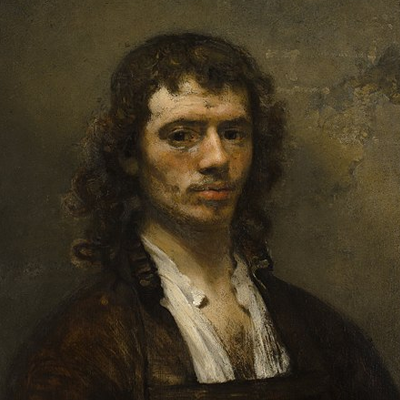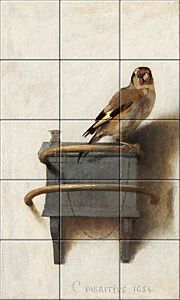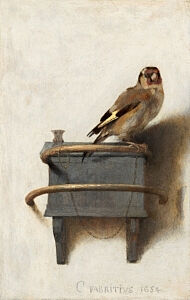We use cookies to make your experience better. To comply with the new e-Privacy directive, we need to ask for your consent to set the cookies. Learn more.

Carel Fabritius
Shop nowCarel Pietersz.Fabritius was baptized on the 27th of February 1622 in Middenbeemster, a small village in the Beemster polder in the Netherlands. He was the son of painter and schoolteacher Pieter Carelsz, and two of his younger brothers Barent and Johannes also became painters.
In 1641 he married Aeltje Hermans Velthuys , and they moved to Amsterdam where they lived in the Runstraat. Aeltje was not without means and it seems likely that she and her family where contributing to Fabritius' training as a painter.
In the early 1640s he studied at the studio of Rembrandt van Rijn in Amsterdam, along with his brother Barent. Carel Fabritius is generally regarded as Rembrandt's most talented student, for whom Vincent van Gogh, among others, expressed his admiration. He was the only pupil in the Rembrandt studio that developed his own artistic style, experimenting with perspective and lighting. Rembrandt would typically use a dark background with a spotlight on the subject whereas in Fabritius’ portraits the subjects are lit delicately and the backgrounds are light-coloured and textured. He stepped outside of the Renaissance focus on iconography and was very interested in the technical aspects of the art of painting. He created shapes by using cool colour harmonies within a luminous style of painting.
He lost his wife Aeltje in 1643, most likely whilst giving birth to their child. The little girl was baptized but unfortunately died soon after. Fabritius moved back to Middenbeemster in that same year.
In 1650 he married widow Agatha van Pruijsen and moved to Delft where he joined the Delft painters' guild in 1652.
Fabritius painted historical pieces, portraits, still lifes and cityscapes. Because of his interest in light, perspective and trompe-l'oeil, he is considered as one of the founders of the so-called Delft school. It is likely that he had a strong influence on Delft's two most famous painters Pieter de Hooch and Johannes Vermeer.
In October 1654 Carel Fabritius was caught in the Delftse Donderslag; an huge explosion in the Delft gunpowder warehouse which destroyed a quarter of the city. He died and his studio and many of his paintings were destroyed, as far as we know only fifteen paintings and 12 drawings survived the fire.
Some of his works are A View of Delft (1652), with a Musical Instrument Seller's Stall and The Goldfinch from 1654, a trompe l’oeil painting where he uses a heavily loaded brush and bold strokes of bright colours at the top and lighter touches of duller colours below to accentuate the visual effect. The viewpoint seems to be from slightly below the bird, suggesting it was intended to be mounted in an elevated position.



